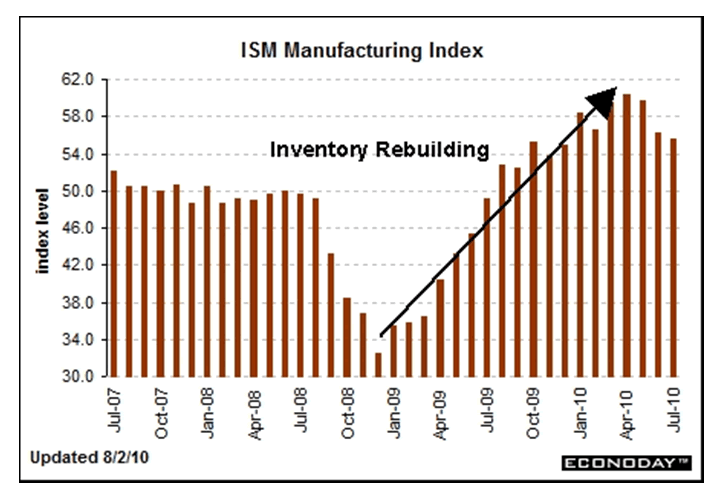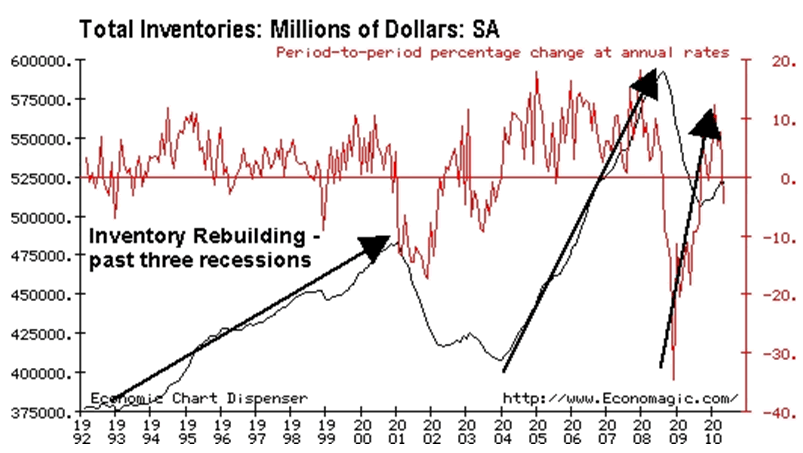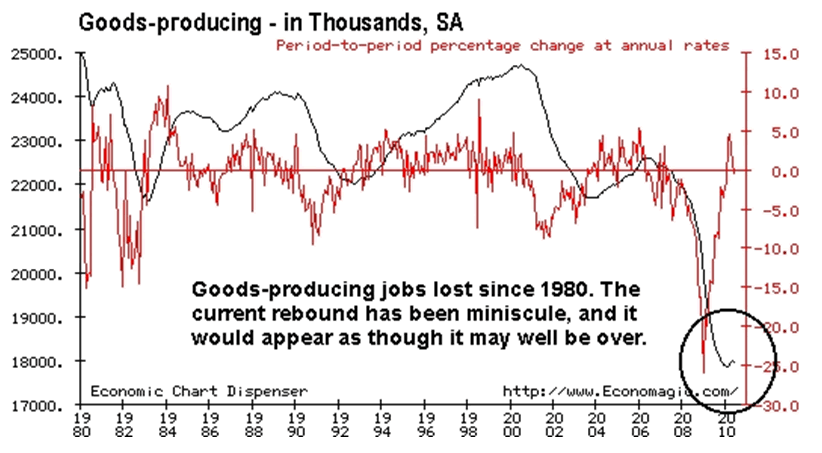The Myth of the Manufacturing-Led Economic Recovery
Economics / Economic Recovery Aug 04, 2010 - 08:31 AM GMTBy: Andy_Sutton
 They still don’t get it – or perhaps they do and just won’t admit it. Either way, it doesn’t matter much as the jesters, namely Msrs. Bernanke and Greenspan, continue to chirp their assigned lines, playing good cop/bad cop with the USEconomy. Right now, Bernanke is the good cop, pointing to increasing wages and the likelihood that the consumer will once again step up and rescue us from the grips of the double dip. On the other side of the room is Greenspan, talking about how that double-dip is still possible, although extremely unlikely.
They still don’t get it – or perhaps they do and just won’t admit it. Either way, it doesn’t matter much as the jesters, namely Msrs. Bernanke and Greenspan, continue to chirp their assigned lines, playing good cop/bad cop with the USEconomy. Right now, Bernanke is the good cop, pointing to increasing wages and the likelihood that the consumer will once again step up and rescue us from the grips of the double dip. On the other side of the room is Greenspan, talking about how that double-dip is still possible, although extremely unlikely.
Today the mainstream press jumped on the bandwagon and trumpeted the smashing success of the ISM’s manufacturing index for June as an indicator that all is and will be well. Stocks soared, bonds shed a point, and oil jumped over $80/barrel for the first time since May.

So what gives with manufacturing anyway? For years now we’ve heard stories about the deindustrialization of America and have seen countless pictures of decaying factories and manufacturing infrastructure. Yet at the same time the economic masterminds of this nation are telling us that manufacturing is going to pull us out of this horrible recession, and in fact, prevent any and all future recessions. If ever there was a dichotomy in perception, it is now. It would appear as if suddenly everyone is realizing that we must produce in order to consume. While this is a notable departure from conventional Keynesian theory, are we seeing a true sea change or just lip service to the common sense of the matter?

Manufacturing currently accounts for about 28% of GDP at just a tad over $400 billion annually (based on final value of shipments) at our current clip, but total goods-producing employment accounts for just 13 million jobs – less than 14% of total US non-farm employment. By contrast, service sector jobs account for a whopping 85.5% of US non-farm employment and provisioning of services accounts for over 70% of GDP.
The Myth of the Manufacturing-Led Recovery
A closer look at the manufacturing activity over the past year jives with direct observation and many conversations with management level staff of several firms. The bump up has been anecdotally nothing more than a period of inventory rebuilding after inventories were run down during the recession. The biggest difference between the recession of the early 1990’s (see chart above) and the last two recessions is the wide acceptance of JIT (just-in-time) inventory management, CRM, ERP, and similar systems as firms broke away from accepting carrying costs as a cost of doing business and made an attempt to streamline operations to compete globally.
The net result of these fundamental changes in the way business is conducted is that inventories are now run down much faster than previously, and the rebuilding phase begins earlier – often while the recession is still in progress. If we had a true manufacturing economy, all else being equal, we might have a reasonable chance of being rescued to some extent by inventory building. However, ultimately, in the absence of an increase in aggregate demand, manufacturing will begin to stagnate again once the rebuild is complete. It should also be noted that the value of inventories is only marginally adjusted for changes in price, hence the increasingly higher dollar amount of goods.

Even though the ISM index made a slightly better showing than what was expected, this was clearly another case of ‘less bad’ being good. New orders continued to slump, down to 53.5 from 57, indicating very sluggish growth and contributing to the idea that the inventory rebuild is nearly complete. The 53.5 reading on the new orders index was the lowest since the same month last year according to the ISM. The backlog index fell by 2.5 points to 54.5 and that, combined with the new orders data, belied the small blip up in manufacturing unemployment and gives considerable credence to the temporary nature of such a move. Of course with the Labor Department solidly fudging the jobs numbers every month it is rather difficult to get a solid reading on anything at this point.
Overall, the composite manufacturing index put in its lowest reading of the year at 55.5. Anything over 50 signals growth with values less than 50 signaling contraction. Even the MSM is now admitting that manufacturing’s role in the continuing ‘recovery’ is becoming suspect. Small wonder.
Bernanke had quite a bit of cold water thrown on his argument as well on Wednesday as auto sales were rather tepid in July, especially when the massive incentives offered by manufacturers were thrown in. The 6% gain in sales will be almost totally wiped out in dollar terms by the slashed prices. Bernanke’s thesis took another blow just an hour later when personal income and outlays were released and neither moved an inch in July. Non-durables and services were particularly weak. Given the contribution to GDP that services represent, this is an unsettling trend.
The bottom line is that services alone will not be able to remove us from our economic and fiscal duress mainly because so many cannot be exported and therefore are of little help to the current account. A strong manufacturing presence would do wonders, however, it is very difficult to ask a struggling consumestocracy to purchase domestic goods at a steep premium to their foreign counterparts. National pride will certainly help some make the leap, but in many cases, the price gaps are just too large.
Tariffs could be used to close the gap, but widespread use could very well put an end to the Chinese (and others) vendor financing of the American economy. The same can be said for import quotas. For all the talk of energy independence, that would only be a microscopic piece of recapturing true national sovereignty. And yes, we have lost a good deal of that by virtue of being dependent on other nations to fill our shelves with everything from soap dispensers to many food items.
As for the current economic malaise? As the chart above shows, the tiny blip in manufacturing jobs represents so small a portion of our labor market that it is nearly laughable that anyone would assert that such a performance will lead this economy anywhere. Yet the spin-doctors continue to do exactly that.
By Andy Sutton
http://www.my2centsonline.com
Andy Sutton holds a MBA with Honors in Economics from Moravian College and is a member of Omicron Delta Epsilon International Honor Society in Economics. His firm, Sutton & Associates, LLC currently provides financial planning services to a growing book of clients using a conservative approach aimed at accumulating high quality, income producing assets while providing protection against a falling dollar. For more information visit www.suttonfinance.net
Andy Sutton Archive |
© 2005-2022 http://www.MarketOracle.co.uk - The Market Oracle is a FREE Daily Financial Markets Analysis & Forecasting online publication.



